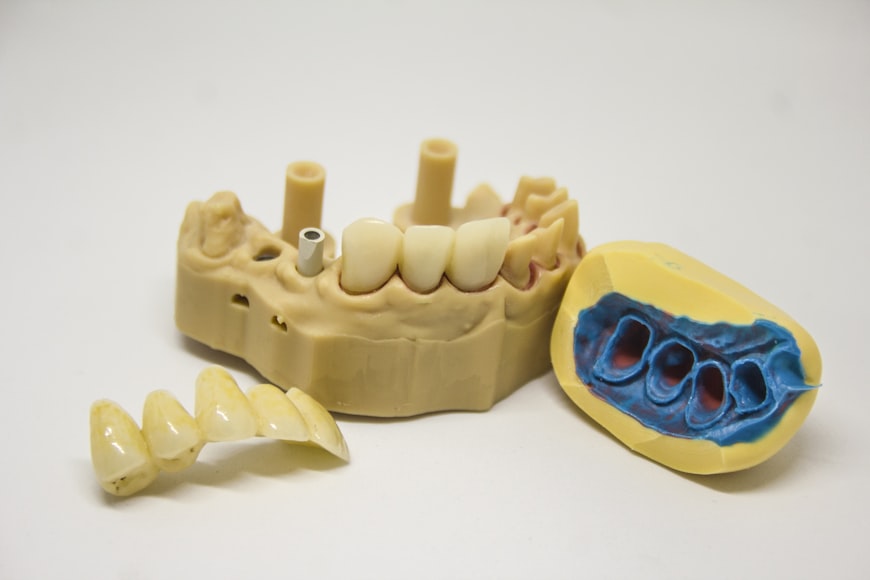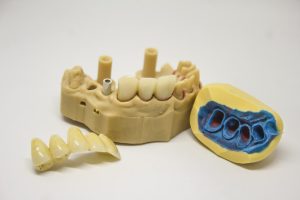TL;DR
- A dental bridge is a permanently cemented prosthetic that replaces one or more missing teeth, supported by adjacent teeth with pontics (artificial teeth) and abutments (supporting teeth with crowns).
- Most effective for patients with missing teeth who have strong, healthy adjacent teeth.
- Types include traditional (supported by teeth on both sides), cantilever (supported by one tooth), Maryland bonded (thin metal/porcelain framework behind teeth), and implant-supported (anchored to implants).
- Materials include porcelain (natural look), porcelain-fused-to-metal (strength and aesthetics), metal (durable for heavy chewing), and zirconia (durable and aesthetic).
- Dental bridges maintain face shape, prevent teeth shifting, distribute bite forces evenly, improve chewing and speaking, boost confidence, last 10-15+ years with care, and are quicker and less invasive than implants.
- Traditional bridges cost $1,500-$5,000, and implant-supported bridges may cost up to $15,000.
- Procedure involves multiple visits (2-3) for consultation, tooth preparation, impressions or 3D scans, temporary bridge placement, and final permanent bridge cementing.
- After placement, avoid hard foods for 12 hours, maintain oral hygiene, floss around the bridge, avoid sticky/chewy foods, schedule regular dental cleanings, and limit staining foods/drinks.
Everything You Need to Know About Dental Bridges
According to the Centers for Disease Control’s NHANES study, more than 35 million Americans are missing all of their teeth in one or both jaws. As dentists, we see every day how even a single missing tooth can change the way your bite fits together, place extra stress on your jaw, and lead to long-term oral health concerns if left untreated.
Fortunately, dental bridges provide a reliable and time-tested solution to restore both function and confidence to your smile. In this dental bridge procedure guide, we’ll provide a detailed overview of different types of dental bridges, who may need them, their benefits, costs, treatment process, and essential tips on caring for them.
What is a Dental Bridge?
A dental bridge is a permanently cemented prosthetic that helps replace one or more missing teeth. It bridges the gap with support from adjacent teeth. It has two main parts:
- Pontics: They serve as artificial replacements that take the place of lost natural teeth. The number of pontics you will need depends on how many teeth need to be replaced.
- Abutments: These are the supporting teeth that act as pillars for the bridge. Crowns are placed on each supporting tooth and attached to a pontic. The natural teeth acting as abutments need to be filed down to accommodate the crowns.
At University Ave Dental, we have seen that dental bridges are most effective for patients who have one or several missing teeth but still have strong, healthy teeth adjacent to the gap. If the teeth next to the gap are diseased, it’s best to treat those first before permanently cementing a bridge.
Types of Dental Bridges: A Guide to Dental Bridges
Dental bridges are selected based on individual needs and patient expectations. The four main types include:
-
Traditional Dental Bridge:
- It is supported by adjacent teeth on both sides of the gap.
- Works well when the surrounding teeth are healthy and strong.
-
Cantilever Dental Bridge:
- Used when there is only one natural tooth next to the gap to serve as support.
- Suitable for areas with minimal chewing pressure, such as the front teeth.
-
Maryland Bonded Bridge:
- Designed with a thin metal or porcelain framework attached behind the supporting teeth.
- It’s minimally invasive, requiring little alteration of neighboring teeth.
- Suitable mainly for front teeth.
-
Implant-Supported Bridges:
- Uses implants instead of natural teeth for anchorage.
- Protects natural teeth and is suitable when the patient lacks healthy support teeth.
What Are the Different Material Options for Dental Bridges?
The choice of material depends on the location of the missing teeth, the patient’s budget, aesthetics, and expectations. Here are some common options:
- Porcelain Crowns: Offer a natural, lifelike appearance, making them ideal for front teeth and visible areas.
- Porcelain-Fused-to-Metal (PFM): Combines the strength of a metal base with the aesthetics of porcelain, providing both durability and a natural look.
- Metal Crowns: Made from gold, stainless steel, or palladium, these crowns are highly durable and suitable for areas under heavy chewing pressure.
- Zirconia: Provides durability and high aesthetic quality. Zirconia bridges are a popular choice for both front and back teeth.
What are the Key Benefits of Dental Bridges?
Dental bridges not only fill gaps in your teeth but also help protect your remaining teeth and jaw from extra strain. Here are some common benefits of dental bridges:
- Maintain your face shape by supporting the structure of your jaw and cheeks.
- Prevents teeth from shifting into the empty space, which can cause bite problems.
- Distributes bite forces evenly across your teeth, reducing strain.
- Improves chewing and speaking, making eating and talking easier.
- Boosts confidence with a natural-looking and complete smile.
- Lasts 10-15 years or more with proper care and regular dental checkups.
- Quick and non-surgical option compared to dental implants.
How Much Do Dental Bridges Cost?
The cost of a dental bridge depends on the type you choose and where you have the procedure done. A traditional bridge usually costs between $1,500 and $5,000, while an implant-supported bridge can be as much as $15,000. If you have dental insurance, it may cover part of the cost, but exactly how much depends on your specific plan.
Dental Bridge Procedure Guide: What to Expect?
The process involves multiple visits, typically 2-3, before the bridge is permanently cemented. Here’s a comprehensive dental bridge procedure guide:
Initial Consultation
The process begins with a detailed assessment of your oral health. The dentist performs a thorough clinical examination, takes X-rays, and discusses your treatment goals, expectations, and budget. This step ensures that a dental bridge is the right solution for your needs.
Tooth Preparation
For traditional bridges, the teeth adjacent to the gap are gently reshaped under local anesthesia to avoid discomfort. A small portion of the tooth structure is removed to make room for the bridge. Implant-supported bridges skip this step since the bridge is anchored directly to the implant.
Impressions or 3D Scanning
Accurate impressions or digital scans are taken to create a bridge that fits perfectly. These scans capture the exact contours of your teeth and bite, ensuring both comfort and proper alignment.
Temporary Bridge
A temporary bridge is placed over the prepared teeth to protect them while the permanent bridge is being made. It also helps you get used to the feel of having a bridge. This temporary solution maintains tooth position and prevents sensitivity during the waiting period.
Final Placement
After removing the temporary bridge, the dentist evaluates the permanent one to ensure it fits well and feels comfortable. Once satisfied, the bridge is permanently cemented.
How to Care for Dental Bridges?

After placement, avoid hard foods for at least 12 hours until the bonding cement sets.
To ensure longevity:
- Maintain good oral hygiene by brushing twice daily.
- Floss around the bridge area; consider water flossers for better cleaning.
- Avoid sticky, chewy, and very hard foods that could damage the bridge.
- Schedule regular dental cleanings to monitor oral health.
- Limit foods and drinks that can stain the bridge, like coffee, tea, red wine, and tobacco.
Final Thoughts
This dental bridge procedure guide is designed to help you understand the treatment, its benefits, and what to expect. A dental bridge not only restores your smile but also improves chewing, speech, and overall oral health. With consistent care, a dental bridge can provide reliable results for years to come.
Want to Restore Your Smile?
Book an appointment with University Ave Dental today! Our team of experienced dentists in blaine is committed to providing exceptional care with same-day appointments. We take our time during consultations to understand your goals and expectations, ensuring personalized treatment every step of the way.
For more information, you can call us at 7637841242 or visit us at 10155 University Ave NE, Suite #112, Blaine, MN 55434, United States.
FAQs
How long does a dental bridge procedure take?
The procedure usually takes 1-2 weeks and may require 2-3 dental visits for preparation, placement, and follow-up.
How long do dental bridges last?
With proper care and regular dental checkups, dental bridges can last 10-15 years or even longer.
Are there any problems related to dental bridges?
Mild tooth sensitivity or gum irritation is common after placement and typically resolves within a few days. Over time, a dental bridge may loosen if the supporting teeth develop decay or gum disease. Good oral hygiene and routine checkups can prevent most issues.
How are dental bridges different from implants?
Dental implants are surgically placed into the jawbone, requiring about 3-6 months of healing before attaching the crown or bridge. Whereas dental bridges do not require surgery and rely on adjacent natural teeth for support. They are quicker and less invasive but may require reshaping healthy teeth.
What can you eat after getting a dental bridge?
You can eat most normal foods once the bridge is adjusted and feels comfortable. However, it’s best to avoid very sticky, chewy, or hard foods that may damage or loosen the bridge.




